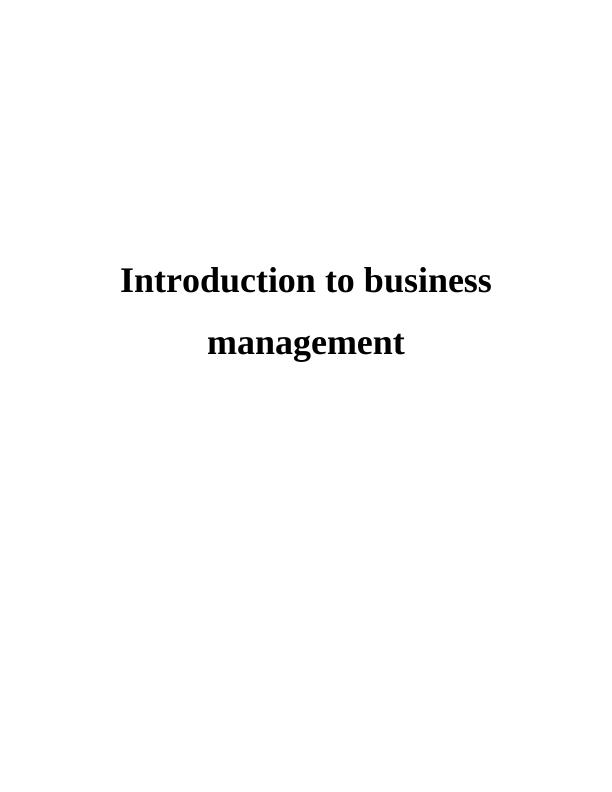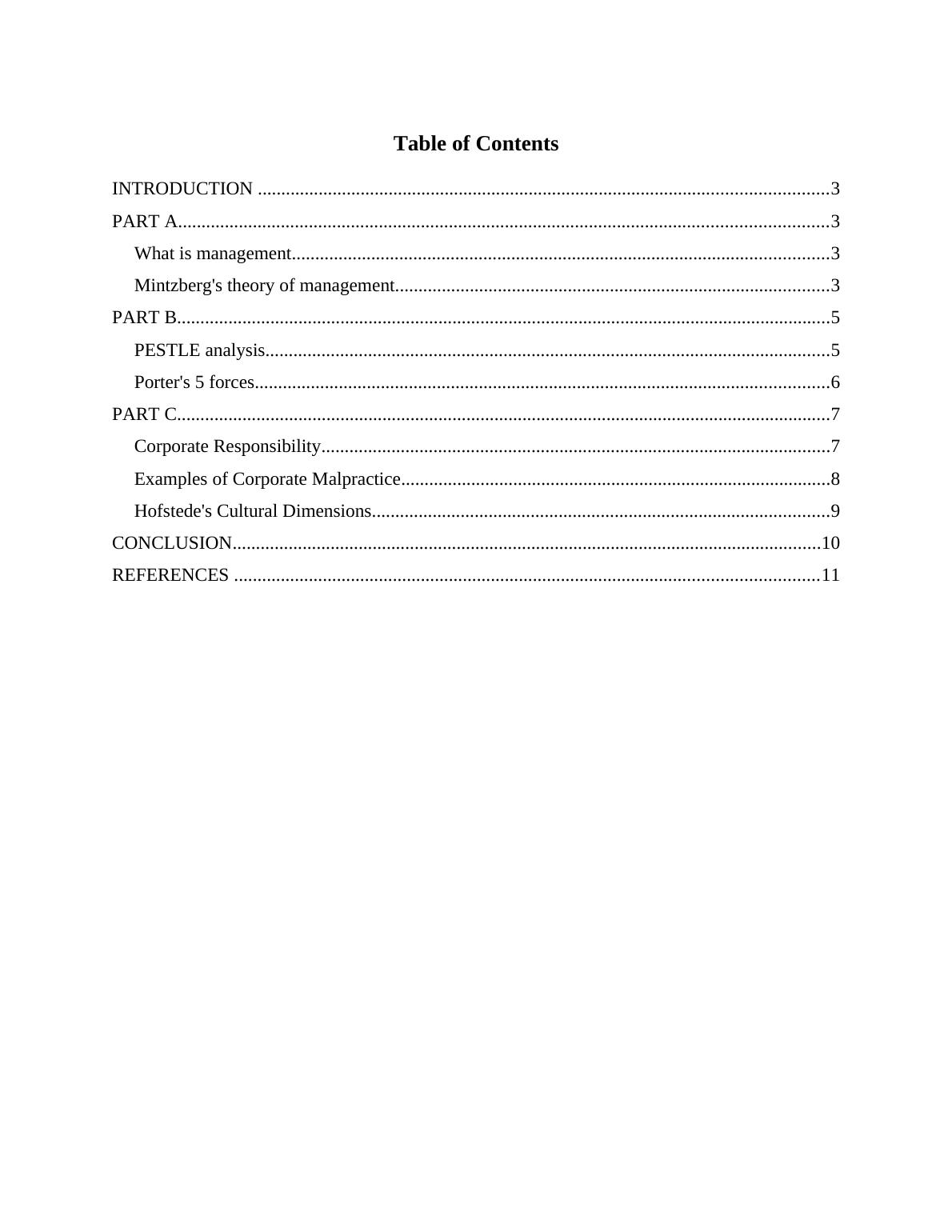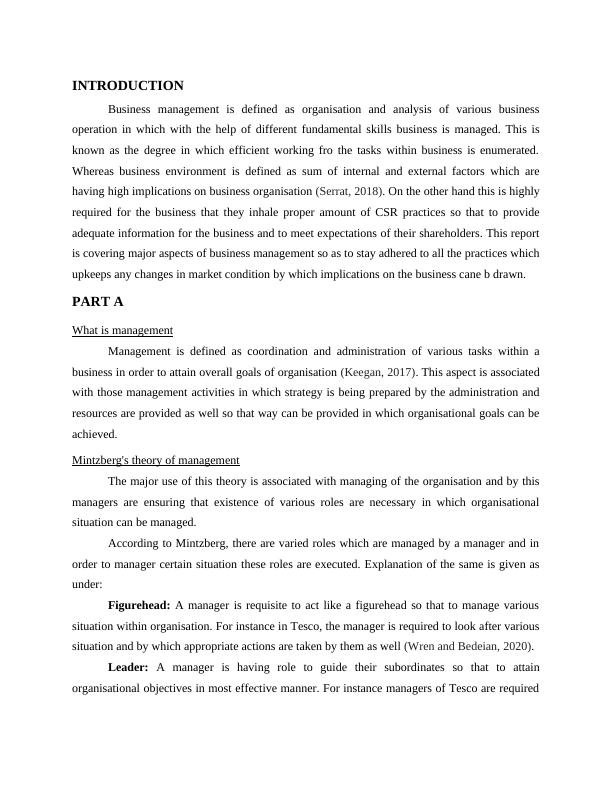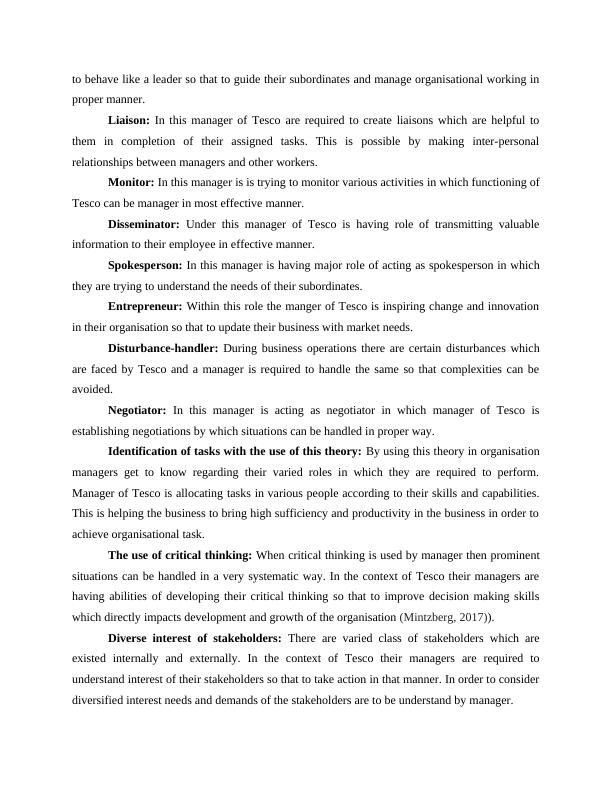Introduction to Business Management
11 Pages3329 Words51 Views
Added on 2023-01-07
About This Document
This document provides an introduction to business management, covering topics such as Mintzberg's theory of management, PESTLE analysis, Porter's 5 forces, corporate responsibility, and Hofstede's cultural dimensions. It explores the fundamentals of business management and its implications on the organization.
Introduction to Business Management
Added on 2023-01-07
ShareRelated Documents
Introduction to business
management
management

Table of Contents
INTRODUCTION ..........................................................................................................................3
PART A...........................................................................................................................................3
What is management...................................................................................................................3
Mintzberg's theory of management.............................................................................................3
PART B............................................................................................................................................5
PESTLE analysis.........................................................................................................................5
Porter's 5 forces...........................................................................................................................6
PART C............................................................................................................................................7
Corporate Responsibility.............................................................................................................7
Examples of Corporate Malpractice............................................................................................8
Hofstede's Cultural Dimensions..................................................................................................9
CONCLUSION..............................................................................................................................10
REFERENCES .............................................................................................................................11
INTRODUCTION ..........................................................................................................................3
PART A...........................................................................................................................................3
What is management...................................................................................................................3
Mintzberg's theory of management.............................................................................................3
PART B............................................................................................................................................5
PESTLE analysis.........................................................................................................................5
Porter's 5 forces...........................................................................................................................6
PART C............................................................................................................................................7
Corporate Responsibility.............................................................................................................7
Examples of Corporate Malpractice............................................................................................8
Hofstede's Cultural Dimensions..................................................................................................9
CONCLUSION..............................................................................................................................10
REFERENCES .............................................................................................................................11

INTRODUCTION
Business management is defined as organisation and analysis of various business
operation in which with the help of different fundamental skills business is managed. This is
known as the degree in which efficient working fro the tasks within business is enumerated.
Whereas business environment is defined as sum of internal and external factors which are
having high implications on business organisation (Serrat, 2018). On the other hand this is highly
required for the business that they inhale proper amount of CSR practices so that to provide
adequate information for the business and to meet expectations of their shareholders. This report
is covering major aspects of business management so as to stay adhered to all the practices which
upkeeps any changes in market condition by which implications on the business cane b drawn.
PART A
What is management
Management is defined as coordination and administration of various tasks within a
business in order to attain overall goals of organisation (Keegan, 2017). This aspect is associated
with those management activities in which strategy is being prepared by the administration and
resources are provided as well so that way can be provided in which organisational goals can be
achieved.
Mintzberg's theory of management
The major use of this theory is associated with managing of the organisation and by this
managers are ensuring that existence of various roles are necessary in which organisational
situation can be managed.
According to Mintzberg, there are varied roles which are managed by a manager and in
order to manager certain situation these roles are executed. Explanation of the same is given as
under:
Figurehead: A manager is requisite to act like a figurehead so that to manage various
situation within organisation. For instance in Tesco, the manager is required to look after various
situation and by which appropriate actions are taken by them as well (Wren and Bedeian, 2020).
Leader: A manager is having role to guide their subordinates so that to attain
organisational objectives in most effective manner. For instance managers of Tesco are required
Business management is defined as organisation and analysis of various business
operation in which with the help of different fundamental skills business is managed. This is
known as the degree in which efficient working fro the tasks within business is enumerated.
Whereas business environment is defined as sum of internal and external factors which are
having high implications on business organisation (Serrat, 2018). On the other hand this is highly
required for the business that they inhale proper amount of CSR practices so that to provide
adequate information for the business and to meet expectations of their shareholders. This report
is covering major aspects of business management so as to stay adhered to all the practices which
upkeeps any changes in market condition by which implications on the business cane b drawn.
PART A
What is management
Management is defined as coordination and administration of various tasks within a
business in order to attain overall goals of organisation (Keegan, 2017). This aspect is associated
with those management activities in which strategy is being prepared by the administration and
resources are provided as well so that way can be provided in which organisational goals can be
achieved.
Mintzberg's theory of management
The major use of this theory is associated with managing of the organisation and by this
managers are ensuring that existence of various roles are necessary in which organisational
situation can be managed.
According to Mintzberg, there are varied roles which are managed by a manager and in
order to manager certain situation these roles are executed. Explanation of the same is given as
under:
Figurehead: A manager is requisite to act like a figurehead so that to manage various
situation within organisation. For instance in Tesco, the manager is required to look after various
situation and by which appropriate actions are taken by them as well (Wren and Bedeian, 2020).
Leader: A manager is having role to guide their subordinates so that to attain
organisational objectives in most effective manner. For instance managers of Tesco are required

to behave like a leader so that to guide their subordinates and manage organisational working in
proper manner.
Liaison: In this manager of Tesco are required to create liaisons which are helpful to
them in completion of their assigned tasks. This is possible by making inter-personal
relationships between managers and other workers.
Monitor: In this manager is is trying to monitor various activities in which functioning of
Tesco can be manager in most effective manner.
Disseminator: Under this manager of Tesco is having role of transmitting valuable
information to their employee in effective manner.
Spokesperson: In this manager is having major role of acting as spokesperson in which
they are trying to understand the needs of their subordinates.
Entrepreneur: Within this role the manger of Tesco is inspiring change and innovation
in their organisation so that to update their business with market needs.
Disturbance-handler: During business operations there are certain disturbances which
are faced by Tesco and a manager is required to handle the same so that complexities can be
avoided.
Negotiator: In this manager is acting as negotiator in which manager of Tesco is
establishing negotiations by which situations can be handled in proper way.
Identification of tasks with the use of this theory: By using this theory in organisation
managers get to know regarding their varied roles in which they are required to perform.
Manager of Tesco is allocating tasks in various people according to their skills and capabilities.
This is helping the business to bring high sufficiency and productivity in the business in order to
achieve organisational task.
The use of critical thinking: When critical thinking is used by manager then prominent
situations can be handled in a very systematic way. In the context of Tesco their managers are
having abilities of developing their critical thinking so that to improve decision making skills
which directly impacts development and growth of the organisation (Mintzberg, 2017)).
Diverse interest of stakeholders: There are varied class of stakeholders which are
existed internally and externally. In the context of Tesco their managers are required to
understand interest of their stakeholders so that to take action in that manner. In order to consider
diversified interest needs and demands of the stakeholders are to be understand by manager.
proper manner.
Liaison: In this manager of Tesco are required to create liaisons which are helpful to
them in completion of their assigned tasks. This is possible by making inter-personal
relationships between managers and other workers.
Monitor: In this manager is is trying to monitor various activities in which functioning of
Tesco can be manager in most effective manner.
Disseminator: Under this manager of Tesco is having role of transmitting valuable
information to their employee in effective manner.
Spokesperson: In this manager is having major role of acting as spokesperson in which
they are trying to understand the needs of their subordinates.
Entrepreneur: Within this role the manger of Tesco is inspiring change and innovation
in their organisation so that to update their business with market needs.
Disturbance-handler: During business operations there are certain disturbances which
are faced by Tesco and a manager is required to handle the same so that complexities can be
avoided.
Negotiator: In this manager is acting as negotiator in which manager of Tesco is
establishing negotiations by which situations can be handled in proper way.
Identification of tasks with the use of this theory: By using this theory in organisation
managers get to know regarding their varied roles in which they are required to perform.
Manager of Tesco is allocating tasks in various people according to their skills and capabilities.
This is helping the business to bring high sufficiency and productivity in the business in order to
achieve organisational task.
The use of critical thinking: When critical thinking is used by manager then prominent
situations can be handled in a very systematic way. In the context of Tesco their managers are
having abilities of developing their critical thinking so that to improve decision making skills
which directly impacts development and growth of the organisation (Mintzberg, 2017)).
Diverse interest of stakeholders: There are varied class of stakeholders which are
existed internally and externally. In the context of Tesco their managers are required to
understand interest of their stakeholders so that to take action in that manner. In order to consider
diversified interest needs and demands of the stakeholders are to be understand by manager.

End of preview
Want to access all the pages? Upload your documents or become a member.
Related Documents
Introduction to Business Managementlg...
|13
|4651
|89
Business Management Assignment | Mintzberg's Theory of Managementlg...
|12
|2594
|340
Introduction to Business Managementlg...
|12
|3584
|47
Introduction to Business Managementlg...
|11
|3289
|49
Introduction to business managementlg...
|12
|4158
|60
Organizational Theory and Practicelg...
|11
|3850
|71
